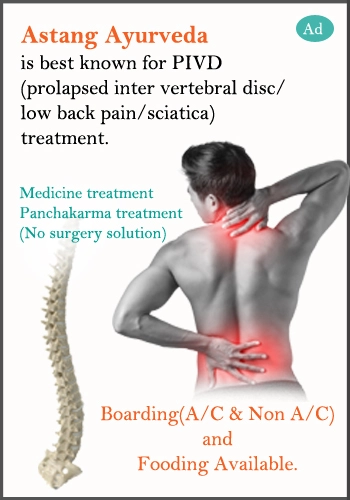CSR Eye Disease Ayurveda Treatment
Ayurvedic Treatment for CSR (Central Serous Chorioretinopathy) eye disease is very much effective now days. Ayurveda medicines and proper panchakarma treatment brings eye disease normalcy gradually like retinitis pigmentosa, glaucoma, myopia.
Contact Us
Call Now:- 09437055021, 07008176012
CSR Eye Ayurvedic Treatment
Treatment methods
- Ghritapan
- Virechan- Snigdha virechan
- Nasya
- Sita Pradeha- cold application to the body and head
CASE PRESENTATION
Patient Name: Dr XXX
Age: 34 Sex: Male
Address: Kabisuryanagar, Ganjam.
Treating Hospital: Astang Ayurveda, Bhubaneswar
Chief complaint:
- Unilateral (RE) blurring of vision since 15 days.
- Smoky, cloudy vision
- Dull central vision for RE -15 days
- Diminish of vision for RE – 15 days
- Heaviness of head since 15 days
- Occasional blackout with distorted vision.
History of Patient Complaints
-
-
- H/O Present illness: patient’s vision was normal before 15 days of occurrence of distorted, smoky, and cloudy vision.
- Patient had been under severe stress due to personal problem since 1 year before occurrence of this vision defect.
- Patient suddenly felt cloudy smoky vision one day morning, before night he took Tab.Viagra (Sildenafil) a sexual stimulant drug.
-
Disease History
Past history: occasionally he felt blackouts since 1 year.
Not a known case of DM/ HTN/ Br. Asthma and other cardio vascular diseases.
-
-
- Family History: NIL
- Drug History: occasionally takes Sildenafil.
- Personal history: occasionally smoke and takes Alcohol.
- Treatment History: he was diagnosed as CSR and was advised Tab Meganeuron OD, Serax forte, FML E/D and Tear Plus E/D.
-
PANCHA NIDAN (DIAGNOSIS)
-
-
- Nidana/ etiology:
-
Kopa, Soka (Stress)
Swapna Viparya (irregular sleep habit)
Atimaithuna(Excessive Sex)
-
-
- Purvaroopa/ Prodormal symptoms: TIA (Blackouts) and Headache
-
-
-
- Roopa / Symptoms
-
Unilateral blurring of vision (RE)
Smoky and cloudy vision
Metamorphosia (Distorted vision) (vyavidhha darshan)
EYE EXAMINATION
-
-
- Visual acuity-RE- 6/18 LE-6/6
- Fundus examination – (Direct Ophthalmoscopy)- elevated , macular edema, no foveal shining and loss of foveal depression.
- OCT- Shallow separation of the sensory retina from the RPE. Cystoid type swelling at macula.
- Lab investigations: FBS, Lipid profile, Hb, Urine- RE/ ME – all were within normal limits.
-
DIFFERENTIAL DIAGNOSIS
-
-
- CSR/ CME/ Eales’ Disease
- Vataja Timir (1st Patalagata / 2nd Patalagat Timir)
- Dhoomadarshi
-
DIAGNOSIS
Dhumadarshi (Pittaja Sadhya Dristigata Vyadhi) affecting 1st and 2nd Patala (Patalagata Timir).
CHIKITSA (TREATMENT MODALITIES)
-
-
- Virechan (Therapeutic purgation) – Sneha virechan with Gandharvahastadi taila.
- Nasya : Tila tailadi Yoga- 3 days (A.H.)
- Anjan/ Eye drops- Chandanadi Anjana E/D (Sahasrayoga) 1drop thrice daily.
- Oral medications:
- Amrutadi Guggulu 500mg BD for 3 months
- Sameerapanchak Capsule 1 cap BD – 3months
- Jathaveda Grita 10gm BD- 3 months
- Saptamrutam Kashayam 15ml BD- 3 months
- Triphala Churna 5gm before bed time daily with Luke warm water.
-
NB: Medicines No. 2, 3 , 4 were procured from Sreedhariyam Ayurveda Eye Hospital, Kerala
| FOLLOW UP FINDINGS |
|
DATE |
VISUAL ACUITY | DIRECT OPHTHALMOSCOPY FINDINGS (RE) | OCT FIDINGS RIGHT EYE | SUBJECTIVE SYMTOMS | |
|
RE
|
LE
|
||||
|
21.12.17 |
6/18
|
6/6
|
Hazy& elevated macula. Loss of shining. Disc normal. No sign of hemorrhages. | Shallow separation of the sensory retina from the RPE. Cystoid type of swelling at macula. complete loss of Foveal depression. | Vision cloudy.Smoky vision Distorted vision |
|
15.02.18 |
6/9
|
6/6
|
Mild Hazy and elevated macula. |
N/A
|
Mild cloudy vision, sometimes blackouts |
|
15.04.18 |
6/6
|
6/6
|
Macula normal, Optic Disc normal |
N/A
|
Normal vision |
|
18.05.18 |
6/6
|
6/6
|
Macula normal Optic Disc normal |
No serous fluid collection between RPE and sensory retina. Edema resolved. Normal foveal depression. |
Normal vision |
|
Before Treatment OCT
|
After Treatment OCT
|
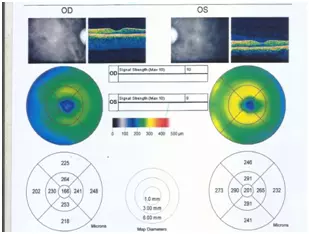 |
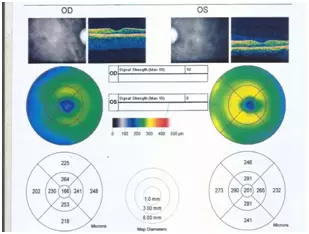 |
|
OCT Before treatment (21/12/17) |
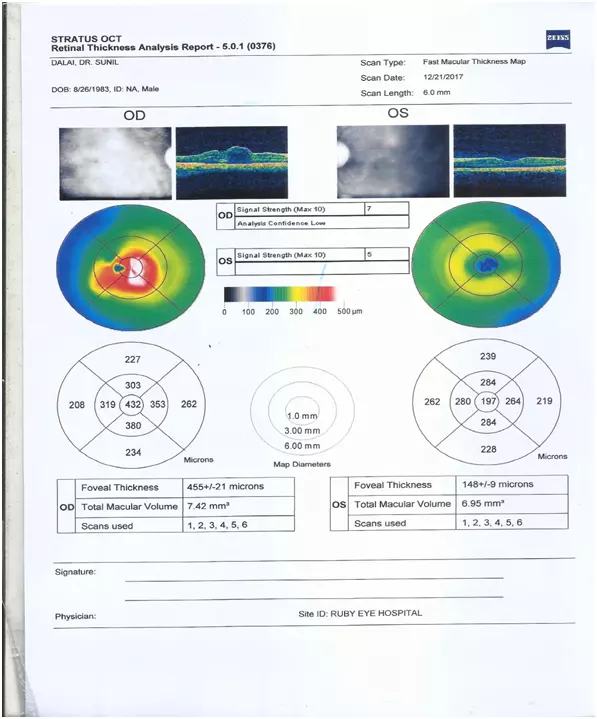 |
|
OCT After Treatment (18/05/2018) |
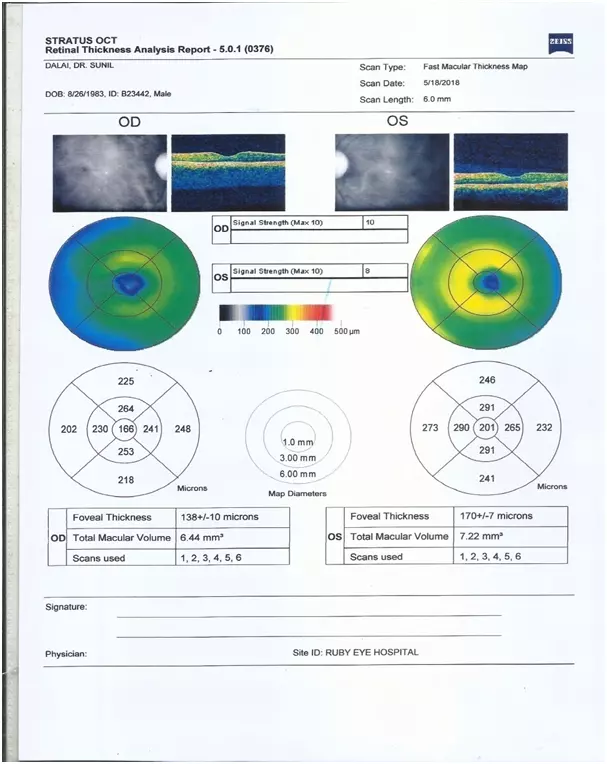 |
RESULT AND CONCLUSION
-
-
- This comes under 1st / 3rd Patalagata Timir as – in first patala the vision becomes avyakta (blurred vision) and in 2nd patala the vision reduced further and patient sees the objects as if covered by rain or cloud.
- Vata Pitta Samak & Kapha abiruddha
- Kaya Shiro Sodhana-Virechan and Nasya (Shamana Nasya)
- The whole treatment was done on the basis of Sheeta chikitsa. Same time eye has to be protected from Kapha- which causes abhisyandi –thus Anjan was advised regularly. i.e Chandanadi Anjan.
- Dhumadarshi chikitsa with Pittasamak drugs / procedure were done to prevent recurrences.
- Pittaja visarpa, pittaja abhisyanda, pitta vidagadha dristi, Raktaja abhisyanda treatment methods should be done in Dhumadarshi. (Su. U.10/16)
- Gritapana, Snigdha virechan, Sheeta pradeha (A.S.U.16/24)
- After treatment vision of the patient become 6/6 for both eyes
- Quality of vision improved
- No Smoky or cloudy vision
-
Summery & Astang Ayurveda Eye Care
-
-
- Though CSR is self limiting disease treatment has to be done to protect gradual degeneration of photoreceptors and RPE which causes permanently reduced vision.
- Daily mild Virechan drug like Triphala Churna has to be advised.
- Daily Gritapana- Triphala Ghrita / Jeevantyadi Ghrita/ Patoladya Ghrita has to be continued.
- Nasya is one of the major procedure where even drug can be cross blood brain barrier (BBB) and blood retinal barrier (BRB).
- Nasya do both Dosha Sodhan and Shaman.
- Divanidra(Day Sleep) and Ratri jagaran (Night awakening)both should be avoided.
- Regular Yoga and Pranayama – for stress relieve.
- At Astang Ayurveda, all type of Eye care provided by eminent Ayurvedic eye specialist.
-
Written by :
Dr Prasanta Kumar Sahoo. M.S (Ay) Shalakya Tantra (Netrarog)
For CSR Ayurveda Treatment, you can Contact our Astang Ayurveda hospital at Bhubaneswar, India.
For inquiry, Call us;
or Mail us;
Get Directions to Our Location on the Map

